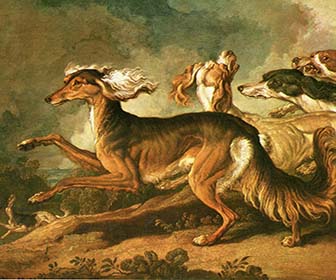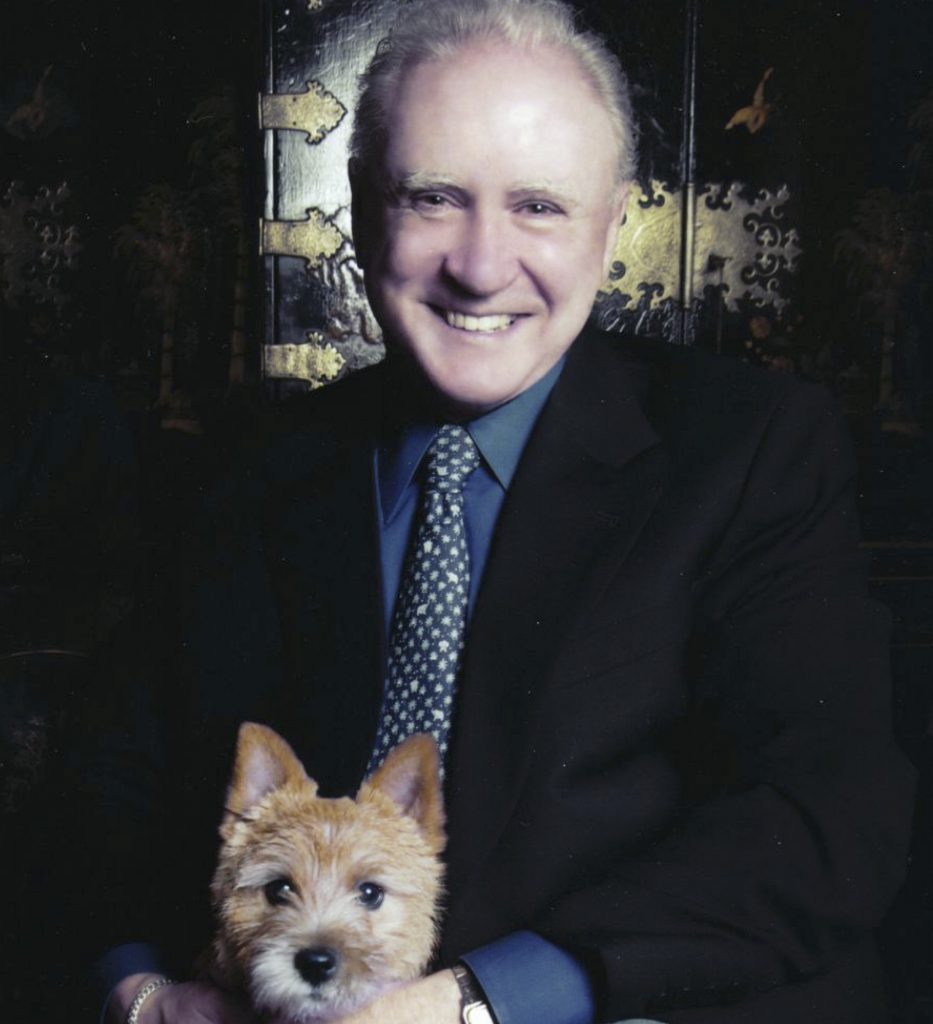503 – Examining the History of Sighthounds with Bo Bengtson
Examining the History of Sighthounds with Bo Bengtson
Bo Bengtson, author, publisher and Whippet breeder, attended his first dog show in 1958 in his native Sweden. He joins host Laura Reeves for a deep dive into the intricacies of sighthounds.
“It was, right away, like lightning struck,” Bengtson said. “I was 14 years old and I just knew right away that this was what I wanted to devote my life to. It was really fascinating. It was, as someone once said, a combination of zoo and circus and theater …
A passion for sighthounds
“You have to know a little bit about coursing if you’re involved in sighthounds. They have remained the same for thousands of years, the basic type. They weren’t breeds early on but different types of sighthounds. if you look at the early description of coursing which is the pursuit of game with sighthounds … that is a sport that’s now these days illegal in most of US… It’s been superseded by lure coursing, which is an artificial form of coursing.

“Hunters Homeward Bound,” 10th Century AD. Courtesy of Bo Bengston.
“(Sighthounds developed) before firearms basically, when the only way you had to hunt was through the dogs and whatever they could course and kill was basically today’s dinner. Firearms made sighthounds very much superfluous. And I think the sport then became very much a status symbol. (Sighthounds) are of course aesthetically pleasing and so many rich people and aristocratic people preferred to hunt with sighthounds, not because of need but because it was a beautiful spectacle and pretty expensive spectacle too. In various parts of the world, Queen Elizabeth I was very fond of coursing. In Russia they coursed with Borzoi. And in the Far East there were Salukis.
What IS a Sighthound?
“There is no official definition of what a sighthound is. So there is a great disagreement about what breeds actually count as sighthounds. You can count as few as four or five as pure sighthounds and as many as 40 as “sighthound related” or different types of breeds we don’t know in this country. Some we wouldn’t define as breeds but more as types.
(Listen to fascinating conversations about the Caravan Hounds of India here and here.)
History of sighthound development
“I think we have to go back again a couple of thousand years because there have probably always been different sizes of greyhounds. Greyhound types. The big ones which were the ancestor of the modern greyhound. And we have the different, smaller ones that were ancestors of whippet and the Italian greyhounds. I think that Whippets, although they weren’t described as a breed until late 1800s, they have certainly been around much longer. Catherine the Great of Russia had little English greyhounds she called them. And they were very important to her. She nursed them herself and they slept on a pink couch in her bedroom. But whether they’re Italian greyhounds, whether they were whippet, who knows. I mean they were very small and whether Italian greyhounds or whippets, it is kind of irrelevant these days.
“The Greyhound and the Saluki are sort of the “ur” sighthound, what sighthounds are supposed to be like. … if you take one step away from Saluki you get the Afghan Hound, which is a little more powerful. If you take several steps away from the Greyhound, you get the Ibizan Hound and you get the Portuguese Podengo and that kind of thing.”
Listen to the full episode for more detailed insights into all things sighthound.
466 – Borzoi: Epitome of Elegant yet Powerful Hound
Borzoi: Epitome of Elegant yet Powerful
Borzoi breeders Kristina Terra and Corrine Miller join host Laura Reeves to learn more about the powerful, elegant sighthounds made popular by Russian nobility.
Once known as the Russian Wolfhound, the Borzoi’s history provides a fascinating study of the Russian aristocracy.
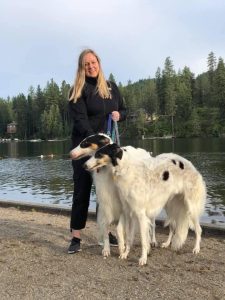 “I think the Russian Wolfhound, it’s a bit of a misnomer,” Terra, president of the International Borzoi Council, said. “Because, actually, the breed in its native land used to hunt many things other than Wolves, but Wolves also. So they were initially bred as a typical sight hound that would hunt the European hare, kind of like a jackrabbit. They’re big in the Russian steppes and the big open spaces but also the forest meadows. So those sighthounds initially had to have a lot of speed on short distances.”
“I think the Russian Wolfhound, it’s a bit of a misnomer,” Terra, president of the International Borzoi Council, said. “Because, actually, the breed in its native land used to hunt many things other than Wolves, but Wolves also. So they were initially bred as a typical sight hound that would hunt the European hare, kind of like a jackrabbit. They’re big in the Russian steppes and the big open spaces but also the forest meadows. So those sighthounds initially had to have a lot of speed on short distances.”
Terra, along with her mother, moved from St. Petersburg, Russia to the United States and acquired their first Borzoi in 1993.
“The first depiction of a Russian wolfhound, Borzoi, is actually at the Saint Sophia cathedral in Kiev, Ukraine,” Terra noted. “It’s one of the frescoes. Since Sophia cathedral dates back to 1037, that is one of the first depictions (of the breed) And also in the illuminated Chronicles of a couple of centuries later, there’s another beautiful depiction of one of the czars hunting with Borzoi. So that’s kind of the second depiction of the breed.
“So the breed goes back ancient and it has changed over the years. Different breeds have been added to it. As the country changed both geographically, you know the forests were cleared, so more stamina was required of a sighthound, the breed changed. Also as the country changed politically, for instance when the serfdom was abolished, when the big aristocratic families of Russia could no longer take care of big kennels, then the breed changed again. But it has always been the symbol of that country and just the epitome of an elegant, yet powerful creature.
“The Royal family is always the one that draws the most attention and just kind of nostalgia, and these beautiful tales and palaces. Of course the Russian czars, they had their own hunt it was the Imperial hunt and it was in the suburb of Saint Petersburg. But one of the biggest breeders and the most famous kennels of the time was actually the czar’s uncle.
“But that was just the czar’s family. There were many Noble families across this vast country and they all considered it their duty to have their own line of beautiful Borzoi and they all competed against each other in how beautiful their Borzoi were, and how fast and agile they were, and how many Foxes or hare or Wolf they could catch.
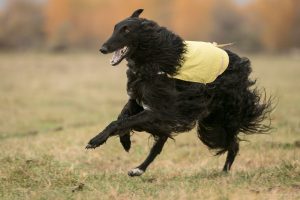 “They would have many kind of field trials, where different neighboring land owners would get together with their dogs and just compare them. The very first written description of the breed appeared in an article in a hunting magazine in 1888. That description was voted on by the Imperial hunting society members. They all voted on that and I suppose that could be called the first standard of the breed.”
“They would have many kind of field trials, where different neighboring land owners would get together with their dogs and just compare them. The very first written description of the breed appeared in an article in a hunting magazine in 1888. That description was voted on by the Imperial hunting society members. They all voted on that and I suppose that could be called the first standard of the breed.”
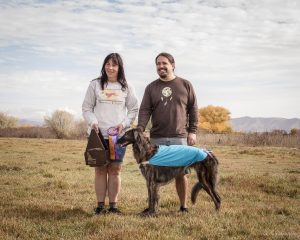 Miller added, “a lot of them (breeders) wrote their own standards, which was interesting. There was one (that was) like ‘oh the black and tan ones are the best’ and then this other guy that lived over the other ways like ‘Oh no, tan markings is bad.”
Miller added, “a lot of them (breeders) wrote their own standards, which was interesting. There was one (that was) like ‘oh the black and tan ones are the best’ and then this other guy that lived over the other ways like ‘Oh no, tan markings is bad.”
282 — John Reeve-Newson: Be Kind and Show Good Manners
John Reeve-Newson: Be Kind and Show Good Manners
John Reeve-Newson graduated from the Ontario Veterinary College in 1964 and soon after that returned to Toronto to establish The Animal Clinics One and Two, where he is still in active practice. He was also the founder of the Veterinary Emergency and Referral Clinic Partnership of Toronto, the first veterinary emergency clinic established in Canada.
In 2006, Reeve-Newson founded the Companion Animal Wellness Foundation, a registered charity that provides funding assistance for the treatment of the critically ill or injured pets of those financially disadvantaged. In 2014, he was made a Companion of the Order of Caring Canadians by the Governor-General.
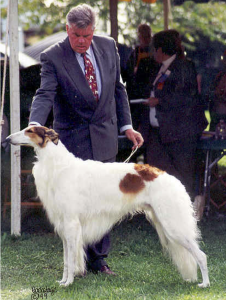
Richard Meen and Am. Can. Ch Kishniga The Tempest, “Sebastian”
With Dr. Richard Meen, they established Kishniga Kennels in 1971. In 1977 Ch. Kishniga’s Desert Song, a Borzoi, bred by Reeve-Newson and Meen, and shown by Meen, was Canada’s top dog all breeds. The following year “Moustache,” as he was called, was exhibited in the USA and was number two hound in the USA. He is still the record holder for the breed with forty-seven all breed BIS in Canada and the USA to his credit. His brother “Dalgarth” was the youngest of his breed to win a BIS, which he did at nine months of age.
As a judge, Reeve-Newson remembers how he was treated as a newcomer and endeavors always to be polite and respectful of all exhibitors and dogs.
“Even if a dog isn’t good, (the dogs) don’t know it,” Reeve-Newson said. “They deserve as much of your attention as a great dog. They deserve to be treated with manners and politeness.”
Reeve-Newson will be judging at the World Dog Show in China next week. While the show venue has received criticism, Reeve-Newson believes in leading by example.
“You’re not going to change anything unless you go and show them a good example,” Reeve-Newson said. “Staying home yapping your mouth off isn’t going to do any good.

